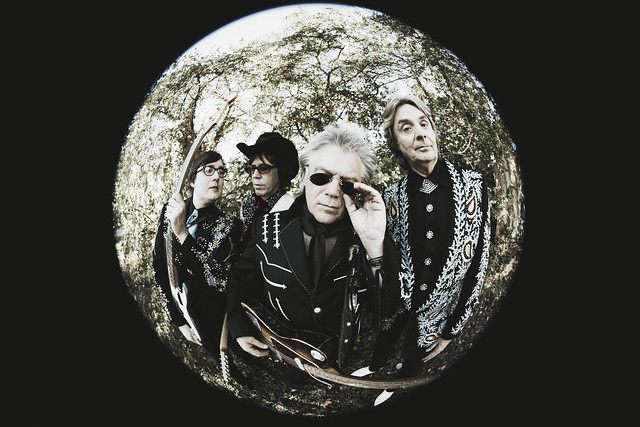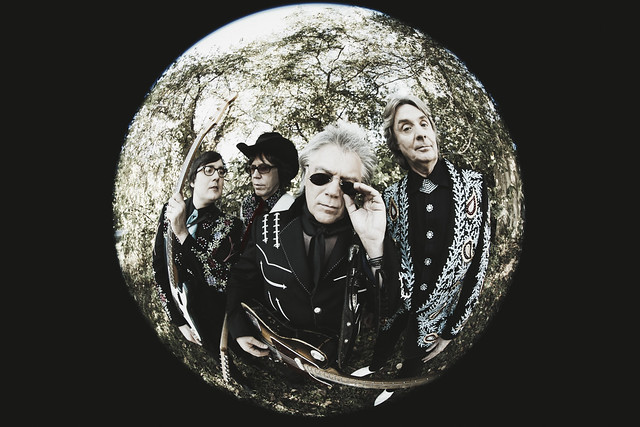
Marty Stuart and His Fabulous Superlatives (Photo by Alysse Gafkjen)
Gathered around a single mic at The Birchmere recently, Marty Stuart and His Fabulous Superlatives played an all-acoustic cover of Tom Petty’s “Runnin’ Down A Dream.” Kenny Vaughan, a winner of the Americana Music Association’s Instrumentalist of the Year, played acoustic guitar. Harry Stinson was on snare drum, and Chris Scruggs, grandson of bluegrass scion Earl Scruggs, was on upright bass.
The cover encapsulated a lot of what this band does: They honor country traditions, but their sonic palette extends well into rock & roll.
The Fabulous Superlatives are one of the tightest bands in country or Americana music, however you want to slice it. In addition to Vaughan’s Instrumentalist award, the whole outfit has received the AMA’s award for best group. For 20 years, they’ve been making music that evokes the spirit not just of Stuart’s one-time mentor, the late Johnny Cash, but the country-rock of bands like The Byrds.
At The Birchmere on Aug. 4, Marty recalled their tour a few years ago with former Byrds Roger McGuinn and Chris Hillman on the occasion of the 50th anniversary of the landmark album Sweetheart of the Rodeo. One of the songs they played every night on that tour was the 1961 Memphis soul song, “You Don’t Miss Your Water (‘Til The Well Runs Dry),” written by William Bell.
The Byrds’ influence also popped up later in the show with “Time Don’t Wait,” a cut from the band’s latest album, 2017’s Way Out West, which was produced by ex-Heartbreaker Mike Campbell and often sounds like vintage mid-’60s psychedelia. The set also included “The Ballad of Easy Rider,” cowritten by Bob Dylan and Roger McGuinn for the Peter Fonda movie.
Watch the official music video for “Time Don’t Wait” by Marty Stuart on YouTube:
While Marty Stuart’s name was on The Birchmere marquee, the Fabulous Superlatives operate more as a collective than as a star and his backing band. Each member of the band had a turn singing lead last week. Kenny did two songs, including “Country Music Got A Hold On Me.” Scruggs honored the western swing tradition with Bob Wills’s “Brain Cloudy Blues,” and Stinson performed Woody Guthrie’s “Ballad of Pretty Boy Floyd.”
Over the course of the show, Stuart himself paid homage to some of his personal icons with Merle Haggard’s “No Hard Time Blues” and Bill Monroe’s “Get Down On Your Knees and Pray.” While Marty doesn’t have a direct connection to the founder of bluegrass, he’s close, having begun his career in Lester Flatt’s band. Stuart went on to play in Johnny Cash’s band while also releasing his first solo album in the early ’80s. His solo career made slow progress and only took off toward the end of the decade, after he’d left Cash’s band. Stuart’s career peaked commercially in the late ’80s and early ’90s, with a series of gold albums and Top 10 hits, including the title cut of Tempted.
Like his idol and teacher, Cash, Stuart has a special connection to Native Americans. When he first formed the Superlatives, he found a home at the Pine Ridge Reservation. He married his current wife, fellow singer, Connie Smith there, and he was adopted by the tribe. He even made a concept album, Badlands: Ballads of the Lakota.
Stuart recalled an incident from his time visiting the reservation. “I wanna go see the place where George Custer got what was coming to him,” he said, referring to the infamous American general who was soundly defeated — and his troops wiped out — in one of the few great victories of Native Americans over the American military. He was taken to Little Bighorn, the site of the battle, as the sun was setting; the experience informed his writing “Trip To Little Bighorn.”
Watch Marty Stuart perform “Trip To Little Bighorn” live on YouTube:
The show started with an instrumental, followed by the title cut of Nashville, Vol 1: Tear the Woodpile Down and another track from the album, “Going, Going, Gone.” The next tune, “Matches,” written by Charlie Craig and Keith Stegall, was a cut from 1992’s Let There Be Country, the release of which was delayed several years by his label.
On Way Out West, Marty and his band also explore surf rock, and they played an all-acoustic version of “Wipeout” in addition to some instrumentals from the album. As they played, I had a revelation: Ennio Morricone’s famed spaghetti Western soundtracks are really just surf rock with more sophisticated instrumentation. The sound of the West, as we’ve come to think of it, is as much a creation of late ’50s and early ’60s southern California as it is anything that actually existed in the Old West of the 19th century.
Another instrumental led off the encore, then a song from 2014’s Saturday Night and Sunday Morning, “Look At That Girl.” The concert ended with “Hobo’s Prayer,” from Stuart’s 1999 country-opera, The Pilgrim. When he was growing up in Philadelphia, Mississippi, the train tracks ran right behind his house and to the factory where his father worked, building engines. “I believe trains are magical,” he said. One day, he encountered a man wearing a “scarf and clothes from another time,” Stuart explained, indicating the very similar garb he wears onstage. He learned the man was a hobo, and promptly told his mother, “I want to be a hobo.”
Stream “Hobo’s Prayer” by Marty Stuart on YouTube:
I doubt Mrs. Stuart was enthused at the prospect of her son riding the rails, but things have turned out pretty well for Marty. He’s become an icon for traditionalists, while continuing to make vital music at the intersection of country and other genres. He’s amassed one of the premier collections of country memorabilia. He’s also an accomplished photographer, and he’s published some wonderful collections of his work, including the gorgeous hardcover The World of Marty Stuart.
If you’re looking for an entry point into country music, you could do a lot worse than turning to Marty Stuart and His Fabulous Superlatives. This is one of the tightest, most skilled bands I’ve seen, and they always put on a great show.







Agreed wholeheartedly!
You say “While Marty doesn’t have a direct connection to the founder of bluegrass…”
Please watch Ken Burns’s documentary series Country Music where Marty recounts some of his “direct connections” to Bill Monroe. He also talked to Guitar Player magazine about these in 2019:
“When I was 12 years old, my dad took me to see Bill Monroe and the Blue Grass Boys. After the set, I went over to where they were selling their records and bought one. Bill looked at me and said, ‘You really want to play the music, don’t you?’ ‘Yes sir, I do,’ I said. ‘I want to play the mandolin, just like you.’
“He had one of those tri-corner guitar picks. It was white and kind of worn. He said, “Will you take this home and learn how to use it?” And I did. It was like having magic in my pocket. It was my secret. It empowered me.”
[GP interviewer: Only a year or so later you landed the gig playing with Lester Flatt, and you mention being tutored by Monroe. How did that go down?)
“Lester Flatt and Bill Monroe did several package tours together right after I joined Lester’s band. The buses would travel in tandem. I would often ride along in the bus with Bill, and we’d play mandolin songs…” In the Burns documentary Marty describes Monroe as being at times stern with him about mastering the instrument. Again, Marty was in his very early teens at the time.
Marty Stuart also performed on stage with Bill Monroe many times, and took some iconic photographs of the founder of bluegrass near the end of his life.
With Cash, Marty also toured for years with the last surviving founder of country music itself, Mother Maybelle Carter.
Other than that one inaccuracy you wrote a great article about one of the greatest living musicians in America. Thanks.